At the very same time that I was on the plane to the UK in August, a very nice email was also on its way to me, an enquiry for a commission to paint a series of 16 bee studies.
How could I refuse such a lovely job?
Thankfully my client is patient, so in between Dad Duties I have been able to a little research and the preparatory sketches.
Later this week when I return to the USA I will be starting the artwork. To a bee novice like me, 16 different bees sounded quite a challenge but there are in fact many many different species of bee to choose from. They come in a variety of shapes, colours, sizes, and surface finishes, the only problem is deciding which ones.
From “Cornell’s Bee Phylogeny” site, here are the main families. (for those like me who may not know, Phylogeny : the evolutionary history of a kind of organism). I did not know there were short and long tongued varieties but that makes sense too when considering the various shapes of flowers.
Short-Tongued Bees
- Colletidae
- Andrenidae
- Stenotritidae
- Halictidae
- Melittidae
Long-Tongued Bees
- Megachilidae
- Apidae
Apidae The bees I am most familiar with, bumbles and honey bees, fall into the Apidae family.
From this family I will be painting a few bumble bees. In particular the gorgeous furry Great Eastern Bumble Bee, Bombus impatiens, the much loved everyday Bombus hortorum the Buff tailed Bumble bee, and then a choice of Red Tailed, Rusty Patched, and maybe the Tricolour.
There has to be a Honey Bee of course, Apis mellifera. and also the huge carpenter bees; the furry, tan coloured, green eyed Valley Carpenter bee Xylocopa varipuncta, and the deep purple and irridescent Violet Carpenter bee Xylocopa violacea, the biggest bee we have in Europe. Euglossa bees, the shimmering and metallic little orchid bees are here too and the comical Long Horned Bee Eucera.
My choice is not particularly scientific..and I am easily swayed by a name, so how could I not include the delightfully named Hairy Footed Flower Bee Anthophora Plumipes
Megachilidae
The very charming leaf cutter bees who may shred your rose leaves but endearingly wrap their little ones in leaf curls. Three from this group I think and one must be the funny little pointed Coelioxys bee, black and white striped with green eyes.
Another the wonderful Wool Carder Bee Anthidium manicatum a big yellow and black bee who gathers the furry hairs from plants like the appropriately named Lamb’s Ear Lychnis coronaria, to line the nest.
Halictidae The group containing the glittering green and gold metallic sweat bees. I have to have one of those.. or even two.
Colletidae From here comes the smart striped Ivy Mining Bees Colletes Hederae black and white with very furry thorax.
Andrenidae Lastly the little Tawny Mining bees Andrena fulva who leave volcano-like mounds in your lawn.
___________________________________________________
There may well be others… this is just my first rough list with some accompanying very rough sketches, in no particular size or order. I will write more about them as I draw them.
Warning Prepare to be bored rigid by bees over the next couple of months. Bee phobes (Apiphobics) should maybe come back in January.

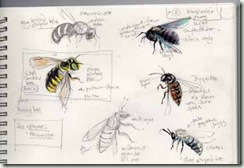
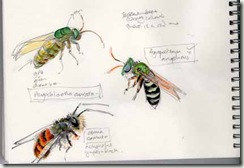
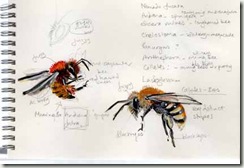


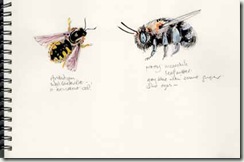
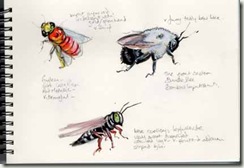





Love the thought of the leaf cutters wrapping their little ones in curls of rose leaves. Beautiful drawings. Bees are fascinating aren't they? Yan
Lovely bees
I have been meaning to tell you that after your encouragement earlier this year I have finally started a botanical drawing class – one evening a week which so far as been excellent. Thanks for all your encouragement. Looking forward to learning more about bees
These are delightful. I sent your blue bee an "award"!
I never knew bees could be so charming! Wrapping their little ones in leaf curls and lining nests with plant hairs?! I live "up north" in Green Bay, WI and love to wake up on our cooler fall mornings to find the bees still "asleep" on the fall asters and goldenrod! Just waiting for the warming morning sun!
We recently found bees had a made a hive in our walls. I've had a lot of experiences with these bees in the last couple of weeks! I live in an apartment and I'm glad to say that the apartment was not allowed to kill the bees because they are protected so they had to hire beekeepers who put a bee box in a tree nearby to relocate the bees. The next day I was sitting in the living room and saw a huge swarm outside… it was so large, longer than one of our 8-home apartment buildings… and it just went on down the backyard, to the road, and off into the distance. A few days later the beekeepers came back and said the bees had not gone in their box at all! But they had left! Very puzzled beekeepers. The bees had relocated themselves- I am VERY impressed! What smart little creatures!!
Now the beekeepers must come back and remove the hive… they might not have to… but I hope they do because I want to see it!!
Anyway, I will not tire of your bee work! I'm very fascinated with them at the moment.
Thank you all for your lovely comments, observations and stories.
Kate…I really hope you get to see the hive, how fascinating that will be.
Jan and Nicole …yes leaf wrapped bees is a sweet thought and I have seen some wonderful photos of sleeping bees on the internet.
PG… you are very welcome .. hope all goes well ..send me some drawings!
EE… Thankyou!!
Your bee sketches are beautiful. I doubt I'll be bored rigid 🙂
Gabrielle.. Thankyou..will try to make them not too tedious!